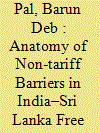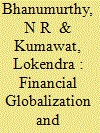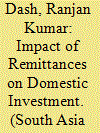|
|
|
Sort Order |
|
|
|
Items / Page
|
|
|
|
|
|
|
| Srl | Item |
| 1 |
ID:
172217


|
|
|
|
|
| Summary/Abstract |
This article attempts to answer one crucial research question: why the utilization of India–Sri Lanka Free Trade Agreement (ISFTA) route for trade is very poor by the Indian exporters (13%) as compared to their Sri Lankan counterpart (65%) even after one decade of its implementation? The available studies have blamed the non-tariff barriers (NTBs) which are hamstringing the growth of trade between these partners development of international trade. However, these have considered NTBs as subset of non-tariff measures (NTMs) which are quite narrow sense of finding the hidden barriers within the International trade process. Therefore, this article has analysed in detail the logistic process involved in international trade between India and Sri Lanka to understand various NTBs sheltered within this logistic process. Further, the article has identified issues which are not directly beyond the logistic process which are affecting the international trade between these two countries.
|
|
|
|
|
|
|
|
|
|
|
|
|
|
|
|
| 2 |
ID:
172213


|
|
|
|
|
| Summary/Abstract |
The article examines relationship between financial globalization and economic growth in South Asian countries namely Bhutan, Bangladesh, India, Maldives, Nepal, Pakistan and Sri Lanka. Following the framework of Bekaert et al. (2005) and with the help of Panel VAR and Panel causality (in GMM framework) models the study concludes that the causation from financial globalization to growth in the region appears to be weak. There appears reverse causation running from growth to financial globalization. We found that domestic macroeconomic policies such as fiscal prudence act as pull factors for foreign capital. The article has some interesting results at individual country level.
|
|
|
|
|
|
|
|
|
|
|
|
|
|
|
|
| 3 |
ID:
172214


|
|
|
|
|
| Summary/Abstract |
Technological advancement can displace workers with machines, but also create new jobs. Hence, at the crux of the matter lies a race between the rate of technological advancement and the pace at which educational institutions can empower workers with the right skills. For the countries of the South Asian region, generating jobs for youth will prove to be a challenge in the backdrop of the Fourth Industrial Revolution. This paper investigates the impact of technological advancement on youth unemployment in the context of six South Asian countries, namely, Bangladesh, Bhutan, India, Nepal, Pakistan and Sri Lanka. The results of the panel instrumental variables model estimations show that lower secondary completion rate has a negative relationship and capital–labour ratio has a positive relationship with the share of youth not in employment, education or training. However, since the magnitude of the coefficient of the lower secondary completion rate is greater than the magnitude of the coefficient of the capital–labour ratio, it is concluded that education will win the race against technology in South Asia, as long as the educational attainment rates are high enough to offset the impact of technical progress.
|
|
|
|
|
|
|
|
|
|
|
|
|
|
|
|
| 4 |
ID:
172218


|
|
|
|
|
| Summary/Abstract |
This article investigates the economic impact of continuing borrowers’ participation in the microcredit programme on poverty eradication in Bangladesh. A panel data set was collected through a field survey for the years 2013–2016 to identify the impact of a microcredit programme on continuous participation borrowers. The propensity score matching (PSM) method is used to eliminate selection bias and the difference-in-difference (DID) model is applied for the empirical analysis. The findings of the study demonstrate that more benefits are realized from continued participants compared to discontinued participants.
|
|
|
|
|
|
|
|
|
|
|
|
|
|
|
|
| 5 |
ID:
172212


|
|
|
|
|
| Summary/Abstract |
Remittances inflow to South Asian countries increased significantly and is now one of the major sources of external finance overtaking traditional capital inflows such as foreign direct investment (FDI), foreign portfolio investment (FPI) and aid. However, the role of remittances in economic development has not been examined extensively, particularly for South Asian countries. This article examines the impact of remittances on domestic investment for South Asia over 1991–2017. Advanced panel estimation methods (unit root, cointegration and causality) are employed to account for potential country-specific heterogeneity and the endogeneity problem. Results of this study suggest that remittances increase domestic investment in the short term as well as in the long run for South Asia. This indicates that remittances are used not only for consumption purposes but also for investment activities such as human and physical capital development. The panel causality results suggest the presence of uni-directional causality running from remittances to domestic investment. Therefore, the result of this study supports the theoretical argument and previous empirical studies for other developing countries
|
|
|
|
|
|
|
|
|
|
|
|
|
|
|
|
| 6 |
ID:
172216


|
|
|
|
|
| Summary/Abstract |
Although currently limited, services trade holds great potential for Bangladesh, as services already make a major contribution to GDP and employment. Services represent an important alternative (in the longer term) or complement (in the shorter term) to ready-made garments (RMGs), which have long dominated Bangladesh’s export mix. The country is poised to see declining RMG export revenues when the country graduates out of least developed country (LDC) status and loses its trade preferences in global markets. To build domestic capacity with a view to developing its services export sector, Bangladesh needs to open its market to services imports. But what approach would be best? Can a plurilateral trade agreement (PTA) like the Trade in Services Agreement (TiSA), whose members have sought to stimulate their services sectors through more liberalized trade, ever be an option? We use a dynamic computable general equilibrium (CGE) model to simulate the effects of TiSA membership on Bangladesh’s economy. The results show that, overall, Bangladesh would derive marginal benefit from TiSA, but employment and exports would suffer. The worst-affected sectors would be agriculture and textiles and clothing, the country’s largest employers. To lessen the impact of increased foreign competition, a regional trade approach is recommended, supported by a sound national services strategy which would include a roadmap for tackling the country’s myriad supply-side shortcomings.
|
|
|
|
|
|
|
|
|
|
|
|
|
|
|
|
| 7 |
ID:
172215


|
|
|
|
|
| Summary/Abstract |
This paper examines the current status of use of Industrial Revolution 4.0 (4th IR) in South Asia and the role and need for regional cooperation to harness the potential and benefits of 4th IR. It examines the development across South Asian countries, their participation in international forums, their level of collaboration and cooperation in technology adaptation and digitalization. Based on secondary data analysis and in-depth meetings with experts, the paper explores the potential of 4th IR in this region and identifies the challenges of South Asian countries. It then presents recommendations on how the South Asian countries can harness the benefits of 4th IR and address their common concerns through collaborations under the South Asian Association for Regional Cooperation (SAARC), so that all member countries can benefit from 4th IR, by leveraging each other’s best practices and comparative advantages. This can help countries in the region to achieve high and inclusive growth and meet their sustainable development goals.
|
|
|
|
|
|
|
|
|
|
|
|
|
|
|
|
| 8 |
ID:
172219


|
|
|
|
|
| Summary/Abstract |
The impact of artificial intelligence (AI) on every aspect of our lives is inevitable and already being felt in numerous ways. Countries are grappling with the opportunities and challenges that AI presents. Among the South Asian countries, India has taken a lead in promoting and regulating AI. However, it lags significantly behind countries such as China or the United States. This article explores India’s AI ecosystem, the threats and challenges it faces, and the ethical issues it needs to consider. Finally, it examines the common concerns among South Asian nations and the possibility of coming together to promote and regulate AI in the region.
|
|
|
|
|
|
|
|
|
|
|
|
|
|
|
|
|
|
|
|
|